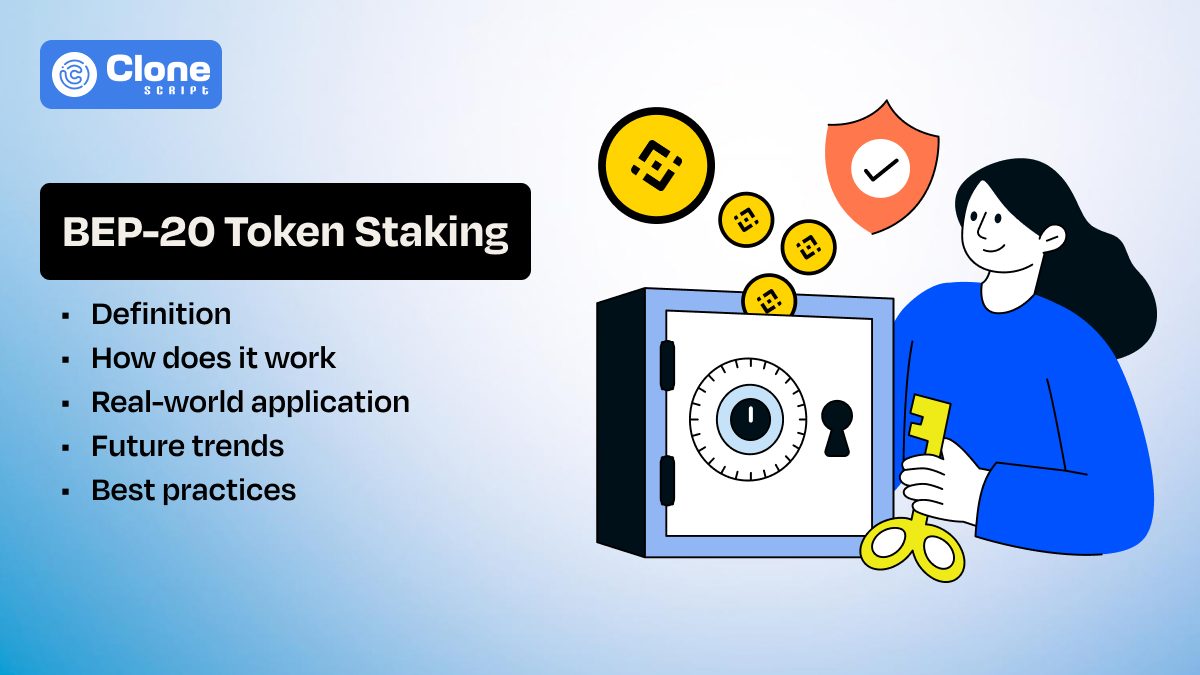What is BEP-20 Token Staking and How Does It Work In Real-life?
Imagine you're holding a golden ticket in the world of cryptocurrencies—a ticket that not only promises potential rewards but also invites you to play a pivotal role in a thriving digital ecosystem. This ticket is BEP-20 token staking on the Binance Smart Chain (BSC).
In the volatile world of digital currencies, staking has emerged as a compelling strategy for investors and crypto enthusiasts seeking to enhance their portfolios and contribute to blockchain ecosystems.
Among the various blockchain platforms, the Binance Smart Chain (BSC) stands out for its efficiency and scalability, largely due to its native token standard, BEP-20. This standard has not only facilitated the creation of a multitude of tokens but has also introduced innovative mechanisms like staking, offering users the opportunity to earn rewards while bolstering network security.
In this article, we will look into the matter of what is BEP-20 token staking and how it works. So stay engaged and make yourself educated.
What are BEP-20 Tokens?
-
BEP-20 is a token standard on the Binance Smart Chain, such as Ethereum's ERC-20. It provides a framework for creating tokens that are compatible with the BSC ecosystem, ensuring seamless interaction across various decentralized applications (dApps) and platforms.
-
This standardization facilitates the development of tokens with diverse utilities, including those used in decentralized finance (DeFi) applications, gaming, and more.
What is Token Staking?
-
Token staking involves locking up a certain amount of cryptocurrency to support the operations and security of a blockchain network. In return, participants earn rewards, often in the form of additional tokens or a share of transaction fees.
-
This process not only incentivizes token holders to actively participate in network governance but also helps maintain the blockchain's integrity.
How Does BEP-20 Token Staking Work?
Staking BEP-20 tokens on the Binance Smart Chain involves several key steps:
-
Choosing a Staking Platform: Participants can select from various platforms, including official Binance staking options, decentralized exchanges (DEXs) like PancakeSwap, or third-party platforms such as Beefy Finance.
-
Locking Tokens: Once a platform is chosen, token holders lock their BEP-20 tokens in a designated smart contract or staking pool. This locking mechanism validates that the tokens are committed to supporting network operations.
-
Earning Rewards: By staking BEP-20 tokens, participants can earn rewards based on factors such as the number of tokens staked and the duration of the stake. Rewards may be distributed periodically and can vary depending on the platform's reward structure and network conditions.
-
Network Participation: Stakers play a vital role in the governance and security of the Binance Smart Chain. Their participation helps validate transactions, secure the network against potential attacks, and influence protocol upgrades through voting mechanisms.
-
Flexibility: Unlike traditional investments, staking BEP-20 tokens offers flexibility. Participants can usually unstake their owned tokens after a particular period or they have a choice to adjust their staking strategy based on market conditions and reward rates.
Real-World Applications of BEP-20 Token Staking
BEP-20 token staking has found practical applications in various DeFi projects:
-
PancakeSwap (CAKE): As a leading DEX on BSC, PancakeSwap allows users to stake CAKE tokens in Syrup Pools to earn additional tokens. This mechanism incentivizes liquidity provision and user engagement.
-
Venus (XVS): Venus is a decentralized money market platform on BSC that enables users to stake XVS tokens. Stakers can earn rewards while participating in the platform's governance, influencing decisions such as protocol upgrades and resource allocation.
What are the Benefits of BEP-20 Token Staking for Crypto Businesses?
For crypto businesses, BEP-20 token staking offers several advantages:
-
Passive Income: Staking provides a means to generate passive income through rewards distributed by the blockchain network.
-
Network Security: By staking tokens, businesses contribute to the security and decentralization of the Binance Smart Chain, enhancing overall network resilience.
-
Governance Participation: Staking often grants businesses a voice in governance decisions, allowing them to influence protocol upgrades and the allocation of network resources.
What are the Risks and Considerations in BEP-20 Token Staking?
While staking presents numerous benefits, it's essential to be aware of potential risks:
-
Market Volatility: Fluctuations in the price of staked tokens can impact the overall value of rewards earned through staking.
-
Smart Contract Risks: Staking involves interacting with smart contracts, which may have vulnerabilities that could be exploited, potentially leading to financial losses.
-
Liquidity Constraints: Staked tokens are typically locked for a specific period, limiting immediate access to funds if needed.
How to Implement BEP-20 Token Staking in Your Crypto Business?
If you're considering integrating staking mechanisms into your crypto business, here are some steps to guide you:
-
Choose the Right Token: Ensure that your crypto token is designed for staking purposes or issued by projects with staking mechanisms enabled.
-
Select a Staking Platform: Evaluate various platforms, including official Binance options, third-party platforms, and DEXs, to determine the best fit for your needs.
-
Understand Staking Terms: Familiarize yourself with terms like staking duration (lock-up period), minimum stake requirements, reward rates (APY – Annual Percentage Yield), and any penalties for early withdrawal.
-
Initiate the Staking Process: Transfer your BEP-20 tokens to the designated staking contract or wallet address provided by the chosen platform. Follow the platform's instructions to confirm your staking transaction.
-
Monitor and Manage Your Stake: Regularly monitor your staking performance through the platform's dashboard or interface. Keep track of earned rewards, staking duration, and overall staking status.
Future Trends in BEP-20 Token Staking
As the blockchain landscape evolves, several trends are shaping the future of BEP-20 token staking:
-
Integration with NFTs and the Metaverse: BEP-20 tokens are increasingly being utilized in non-fungible token (NFT) platforms and metaverse projects. This integration enhances the utility of staked tokens and allows holders to participate in virtual economies and digital asset ownership.
-
Enhanced Tokenomics: Projects are adopting advanced tokenomics strategies, such as deflationary mechanisms like token burns and innovative staking rewards. This creates more value for token holders and ensures long-term sustainability.
-
Regulatory Compliance and Transparency: With increasing regulatory scrutiny, BEP-20 projects are implementing Know Your Customer (KYC) and Anti-Money Laundering (AML) measures. This compliance improves trust and attracts institutional investors.
-
Interoperability and Cross-Chain Functionality: Efforts to enhance interoperability between different blockchain networks are gaining momentum. BEP-20 tokens are being designed to work seamlessly across various chains, broadening their applicability and user base.
Best Practices for BEP-20 Token Staking
To maximize the benefits and minimize the risks associated with BEP-20 token staking, consider the following best practices:
-
Conduct Thorough Research: Before staking, thoroughly research the project and platform. Assess the project's credibility, the security of its smart contracts, and the transparency of its operations.
-
Diversify Staking Investments: Avoid putting all your tokens into a single staking pool. Diversifying across multiple projects can mitigate potential losses due to unforeseen issues in one platform.
-
Stay Informed About Market Conditions: Keep in touch with market trends and news that could impact the value of your staked tokens. Being informed enables you to make timely decisions regarding staking and unstaking.
-
Understand the Terms and Conditions: Familiarize yourself with the staking platform's terms, including lock-up periods, reward structures, and withdrawal policies. This can help to avoid unexpected limitations or penalties.
-
Use Reputable Platforms: Choose well-established and reputable staking platforms known for their security measures and user support.
Conclusion
BEP-20 token staking presents a wealthy opportunity for crypto businesses to generate passive income, engage in network governance, and contribute to the security of the Binance Smart Chain ecosystem. By staying informed about emerging trends and adhering to best practices, businesses can effectively navigate the staking industry and take its benefits for strategic growth.
As the decentralized finance space continues to mature, the BEP-20 token is ready to play a key role in shaping the clear path for crypto investments and blockchain applications.
Looking for a BEP-20 token staking service for dApps services with the smart contract? Contact us. We offer a comprehensive solution and setup to start staking your token on BSC.
 BTC - Bitcoin
BTC - Bitcoin
 USDTERC20 - USDT ERC20
USDTERC20 - USDT ERC20
 ETH - Ethereum
ETH - Ethereum
 BNB - Binance
BNB - Binance
 BCH - Bitcoin Cash
BCH - Bitcoin Cash
 DOGE - Dogecoin
DOGE - Dogecoin
 TRX - TRON
TRX - TRON
 USDTTRC20 - USD TRC20
USDTTRC20 - USD TRC20
 LTC - LiteCoin
LTC - LiteCoin







